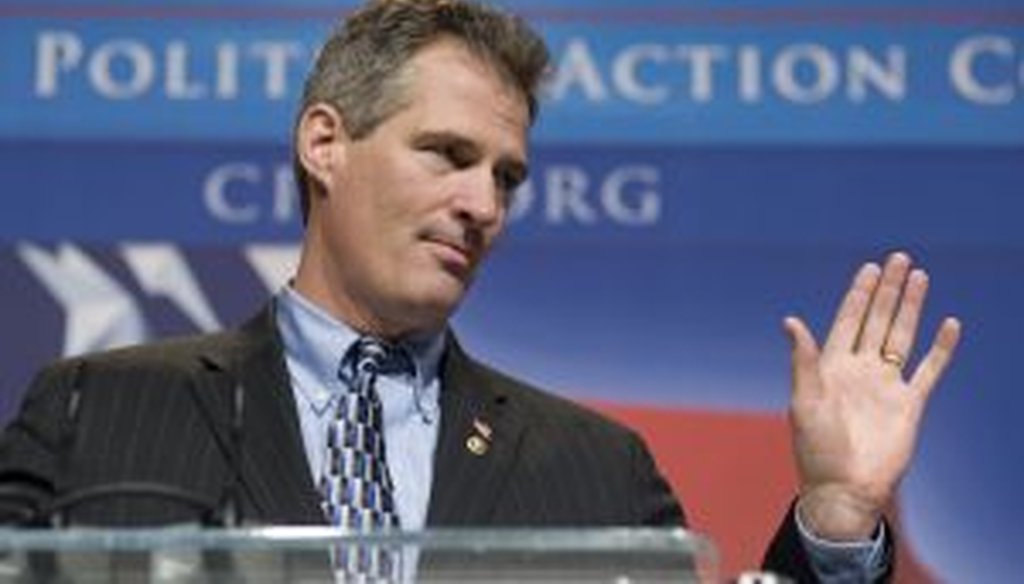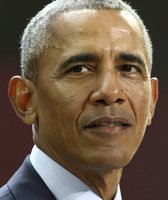Get PolitiFact in your inbox.

Sen. Scott Brown has said the economic stimulus "didn't create one new job." That prompts us to set the meter on fire.
One year after President Barack Obama signed the big economic stimulus bill into law, Republicans and Democrats are still squabbling. Republicans say the $862 billion program is wasteful, poorly managed and that it failed to create many -- if any -- jobs. But Democrats say it created 2 million jobs and kept the economy from a catastrophic collapse.
What's the truth? On the one-year anniversary, we decided to take a closer look at two of the most controversial questions about the stimulus. How many jobs has the stimulus created? And how and where is all that money going?
How many jobs?
The stimulus, officially known as the American Recovery and Reinvestment Act of 2009, includes an array of tax cuts and spending programs designed to pump money into the economy and reverse the recession.
In a speech to mark the anniversary Wednesday, Obama reiterated a claim he made in his State of the Union address, that the stimulus has already saved or created 2 million jobs. And, he said, "These aren't just our numbers; these are the estimates of independent, nonpartisan economists across the spectrum. "
White House officials have repeated that for months. And yet, a recent CBS News/New York Times survey found that just 6 percent of the American public believes the stimulus has created jobs (an additional 41 percent believes that while it hasn't yet created jobs, it will). So there's a huge disparity between what the public believes and what the White House contends.
One possible factor: the unemployment rate, which remains about 10 percent. Republicans often cite that figure as evidence the stimulus has failed.
As with virtually any economic issue, there's disagreement among economists on how many jobs the stimulus created.
To count the jobs created by the stimulus, they essentially have been comparing two numbers: the actual employment statistics from the federal government, and an estimate of what those employment numbers would have been had there been no stimulus. The gap between these two figures represents the number of jobs created or saved by the stimulus.
In a report released on Jan. 13, 2010, the president's Council of Economic Advisers estimated that between 1.77 million jobs and 2.07 million jobs were created or saved by the stimulus through the fourth quarter of 2009.
To back up that claim, the council's report cited four independent analyses of the same question. These estimates were by the Congressional Budget Office, an independent agency that does the number-crunching for Congress, as well by three private sector economic-analysis firms. Here's what those groups found:
-- CBO: Between 800,000 jobs and 2.4 million jobs.
-- IHS/Global Insight: 1.25 million jobs
-- Macroeconomic Advisers: 1.06 million jobs
-- Moody's economy.com: 1.59 million jobs
So Obama has cherry-picked the highest number of the most favorable estimates. For him to be right about 2 million jobs having been created or saved would mean using the highest end of the administration's own range, or the highest end of the CBO's range. Indeed, leaving the CEA's analysis out of it and looking only at the independent estimates, you get an average of 1.38 million jobs created or saved, which is about 30 percent lower than the president's 2 million-job-benchmark.
However, if you fast-forward the employment estimates by one quarter -- to the first quarter of 2010 -- the numbers creep closer to what Obama and other Democrats are suggesting. Using updated estimates provided to PolitiFact, IHS/Global Insight estimates that 1.7 million jobs will be created or saved during the first quarter of 2010. And Moody's economy.com estimated that 1.9 million jobs will be created or saved by that quarter.
So the president's claim of 2 million jobs created or saved is on the generous side, but most independent economic forecasters agree the stimulus has created something close to that number so far.
"Our short answer is that the stimulus has had a big impact, and has helped bring the economy out of recession," said Gus Faucher, director of macroeconomics at Moody's Economy.com.
So while unemployment rose through 2009, Faucher wrote in a December report, "Job losses would have been much more severe without the government's support. Yet a political problem remains; although the economy is expanding, it is still losing jobs on net. And until the labor market sees clear improvement, President Obama's political stature will suffer.
"Given political and economic realities, however, there's only so much the administration can do. Job growth will pick up as the economy improves, but federal action can only induce employers to hire at the margin. The stimulus is working, but we won't see the results in the labor market until early (2011)."
How much is being spent, how fast, and where's it going?
First, the cost.
In January, the nonpartisan Congressional Budget Office revised its estimate of the 10-year cost of the stimulus to $862 billion ($75 billion more than originally anticipated).
From Day 1, the White House has stressed the need to get that money spent as quickly as possible to try to jolt the plunging economy. And so the White House has been fond of noting that nearly 70 percent of the stimulus act spending has already been obligated to specific programs and projects. Critics, however, say less than a third of the stimulus dollars have actually been spent.
They're both right. While money for some projects has been "obligated," it could take years in some cases for that money to actually be spent -- and get into the economy.
The numbers can be sliced different ways. But here are the basics:
Although people often think of new highways and public works projects as the meat of the stimulus, projects like that only account for a portion of the recovery act.
Nearly a third of the cost of the stimulus, $288 billion, comes via tax breaks to individuals and businesses. The tax cuts include a refundable credit of up to $400 per individual and $800 for married couples; a temporary increase of the earned income tax credit for disadvantaged families; and an extension of a program that allows businesses to recover the costs of capital expenditures faster than usual. The tax cuts aren't so much spending as money the government won't get -- so it can stay in the economy. Of that $288 billion, the stimulus has resulted in $119 billion worth of tax breaks so far.
The stimulus also has $499 billion in spending. That includes $226 billion for projects such as new roads and high-speed rail; $273 billion in payments to state governments for things such as hiring teachers and police officers, and for services such as extended unemployment insurance and health coverage.
According to an analysis by Pro Publica, an online news service, $179 billion of the total stimulus has actually been spent. Another $154 billion has been committed, or is "in the process" of being spent.
The Pro Publica report also tracks the spending by agency to see which ones are moving money faster than others. Pro Publica found: the Social Security Administration, the Railroad Retirement Board and the Department of Veterans Affairs each spent the bulk of their money last spring with one-time payments of $250 to beneficiaries. But other agencies have been much slower. The Department of Energy, for example, has spent just 4 percent of its stimulus dollars, and has nearly $20 billion yet to be obligated, almost half its total authorization. Other agencies with substantial amounts still unspent include the Departments of Defense, Interior and Homeland Security.
The CBO also examined the numbers and found that about $200 billion of the stimulus (including payments, projects and tax cuts) was spent in 2009. More than double that, $404 billion, will be spent in 2010. And another $258 billion will be spent in the eight years after that.
The Obama administration says it has tried to strike a balance between a rapid infusion and a steady medicine to make the economy healthy again.
In an annual report on the progress of the stimulus on Feb. 17, the Obama administration said, "By design, it includes some investments that spent out immediately, and others that kick in later so that the stimulating affects of the act support a more sustained recovery."
Our Sources
White House Web site, Annual Report to the president on Progress Implementing the American Recovery and Reinvestment Act of 2009, Feb. 17, 2010
Recovery.gov, U.S. government’s official website providing easy access to data
related to Recovery Act spending
Pro Publica, "Stimulus: How Fast We're Spending Nearly $800 Billion," by Christopher Flavelle and Jeff Larson
Pro Publica, "A Stimulus Birthday Present: Our Spending Speed Chart," by Christopher Flavelle, Feb. 16, 2010
CBS News, CBS News/New York Times Poll, "The President, Congress and Dissatisfaction with Government," Feb. 11, 2010
Reuters, "On anniversary, Obama defends economic stimulus," by Steve Holland, Feb. 17, 2010
White House Web site, Council of Economic Advisers, Quarterly Report: The Economic Impact of the American Recovery and Reinvestment Act of 2009, Jan. 13, 2010
Congressional Budget Office, The Budget and Economic Outlook: Fiscal Years 2010 to 2020, January 2010
Congressional Budget Office, Report: Estimated Impact of the American Recovery and Reinvestment Act on Employment and Economic Output as of September 2009 , November 2009
Government Accountability Office, Report: Recovery Act, Recipient Reported Jobs Data Provide Some Insight into Use of Recovery Act Funding, but Data Quality and Reporting Issues Need Attention, November 2009
CNN, "2 million jobs from stimulus - White House," by Tami Luhby, Jan. 13, 2010
Heritage Foundation, "Why Government Spending Does Not Stimulate Economic Growth: Answering the Critics," by Brian M. Riedl, Jan. 5, 2010
Heritage Foundation,"White House Report Claims Stimulus Success-Despite 3.5 Million Job Losses," by Brian M. Riedl, Jan. 14, 2010
Heritage Foundation, "CBO Says Stimulus Is Working Because We Predicted It Would," by Brian Riedl, Dec. 1, 2009
Moody's Economy.com, "How We Know the Stimulus Is Working," by Augustine Faucher, Dec. 4, 2009
Moody's Economy.com, Written Testimony of Mark Zandi Chief Economist and Cofounder of Moody’s Economy.com Before the Joint Economic Committee, The Impact of the Recovery Act on Economic Growth, Oct. 29, 2009
Barack Obama, remarks by the president and the vice president on the anniversary of the signing of the Recovery Act, Feb. 17, 2010
Council of Economic Advisers, "The Economic Impact of the American Recovery and Reinvestment Act of 2009, Second Quarterly Report," Jan. 13, 2010
Congressional Budget Office, estimate of the economic effects of the American Recovery and Reinvestment Act of 2009 (letter to Sen. Charles Grassley), March 2, 2009
Congressional Budget Office, "Estimated Impact of the American Recovery and Reinvestment Act on Employment and Economic Output as of September 2009," November 2009
IHS/Global Insight, updated figures for stimulus effects on GDP and jobs, Feb. 2010 (provided to PolitiFact by IHS/Global Insight)
Moody's economy.com, "Forecast Comparison: Baseline vs. No ARRA stimulus scenario," accessed Feb. 17, 2010, (provided to PolitiFact by Moody's economy.com)
Augustine Faucher, "How We Know the Stimulus Is Working," Dec. 4, 2009
Macroeconomic Advisers, "The US Economic Outlook: Is the Upturn Imminent? How Strong?" June 11, 2009 (provided to PolitiFact by Macroeconomic Advisers)
Macroeconomic Advisers, Macroeconomic Advisers' Outlook Commentary, Sept. 3, 2009, (provided to PolitiFact by Macroeconomic Advisers)
Brian M. Riedl, "White House Report Claims Stimulus Success-Despite 3.5 Million Job Losses" (briefing paper), Jan. 14, 2010
New York Times, "Judging Stimulus by Job Data Reveals Success," Feb. 17, 2010
E-mail interview with Gus Faucher, director of macroeconomics with Moody's economy.com, Feb. 17, 2010
E-mail interview with Joel Prakken, chairman of Macroeconomic Advisers, Feb. 17, 2010
E-mail interview with Dean Baker, co-director of the Center for Economic and Policy Research, Feb. 17, 2010
Interview with Nan Gibson, chief of staff for the president's Council of Economic Advisers, Feb. 17, 2010

















































